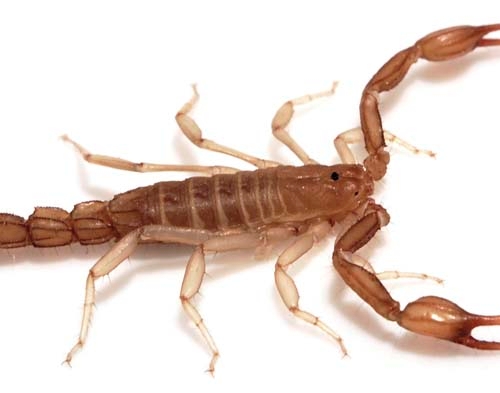UNLV students discover new scorpion species
Two UNLV researchers have provided more evidence that we human beings have a lot to learn about what's going on out there.
Graduate students Michael Webber and Matt Graham have discovered, documented and reported on a new species of scorpion, found in Death Valley National Park.
"I think people don't appreciate how often new species are discovered," Graham said. "What's really neat about this one is it was an especially rare genus."
Graham, 32, and Webber, 27, are doctoral students in biology. They both study scorpions.
There are almost 2,000 different species of scorpions already known. They can be smaller than a staple or bigger than the screen on an iPad.
Wernerius inyoensis measures 16.4 mm, about two-thirds of an inch. It could sit on top of a dime and have room to spare.
The scorpion Graham found is the only one ever documented, despite the fact that he found it in a national park, one of the more heavily studied wilderness areas.
They wrote about their findings in the scientific journal ZooKeys in March.
It all started in late 2008 and early 2009, when Graham was part of a team working for the National Park Service. He'd come to the University of Nevada, Las Vegas from West Virginia specifically so he could be in the middle of scorpion country.
He's one of those guys who had all kinds of critters in his house as a young man.
So the park service had this inventory project going in Death Valley. It's hard to manage a geographic area if you don't know what's out there to manage, so they wanted a basic count on the critters in the park.
You can't tell if environmental changes are killing off certain species, for example, if you don't have at least a rough idea of how many you started with.
It turns out, that's exactly what Graham is interested in, anyway. He studies how climate changes in the past have affected scorpion populations. Scorpions, which have been around for 400 million years, are ideal for studying this sort of thing. They don't move around well, like flying insects do, so they're pretty much stuck with whatever nature throws at them.
During the count, the workers, Graham included, would basically just walk around looking for stuff. They'd document what they found and move on.
It was best to do this at night. First, it's Death Valley, which can get a bit warm in the daytime. And second, scorpions glow in the dark when they're exposed to a black light.
So hunting them is kind of easy at night. Whip out a black light and, voilà, glowing stuff all over the place.
It was on his last night doing the inventory when Graham made the discovery.
He and his dad were out there, getting skunked. Not a single scorpion.
Then, near the bottom of a pile of rocks, Graham saw a really tiny one. He picked it up with tweezers.
Hmm, he thought. There's something different about this one. He brought it back to the truck, where he could look at it in the light. The claws and tail were too thick for such a small scorpion. He was sure of it.
He brought it back to his lab at UNLV. He froze it and took photos.
Then he broke it apart. He put pieces of it into a machine that would analyze the DNA, a key to figuring out if this particular scorpion really is a different species. If the DNA matched a sample already out there, it wasn't a new species.
It didn't match, but there was still the possibility that it could match a known species whose DNA hadn't been sequenced yet.
So, he plopped the rest of the carcass into an alcohol solution and called Webber for help.
Webber used to study the reproductive systems of rattlesnakes. She switched to scorpions because they're a better model to figure out the things she's interested in, such as what it "cost" a female to reproduce.
The ones she studies can have 30 offspring at a time.
The two scorpion experts studied this thing closely. They measured every single piece of it, used a microscope to count all the hairs on its tiny legs, cut it open and noted the shape of the reproductive organs (this one was a male scorpion).
A literature search was called for. This is when scientists search all the academic journals for write-ups by other scientists. The goal is to see if anyone had ever written about a scorpion exactly like this one.
Nope, no one had.
This and the DNA evidence meant they had a new species. They named it after Death Valley's Inyo Mountains, where they found it.
Then they went back out there, hoping to find more. They had no luck.
That got them thinking. Clearly, there's more than one out there. So why didn't they find any more?
Thinking back about where he found the scorpion, Graham got to wondering. Is it possible that this species spends almost all its time living underground? Under that pile of rocks?
That would be new. It would also create a mystery.
How many other things are living right under our noses that we've never even seen?
Contact reporter Richard Lake at rlake@reviewjournal.com or 702-383-0307.























